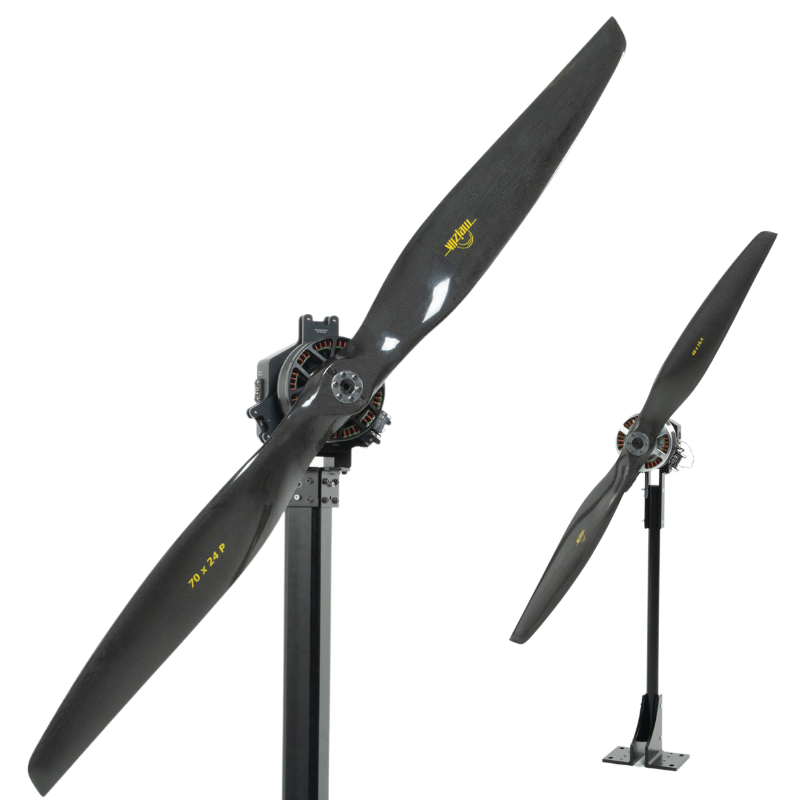Excess vibration is a performance-killer in UAVs, leading to premature component degradation, reduced flight time, unstable video recordings, and other adverse consequences.
One of the major sources of this vibration is imbalanced propellers, where mass is unevenly distributed across the blades. This imbalance may be present coming out of the factory, or it can occur due to damage during transport or operation.
In this article, we review studies that explore the relationship between propeller imbalance and vibration, and provide a recommendation for how to limit vibration in UAVs.
Table of Contents
-
Vibration vs. RPM and Propeller Diameter
-
Developing a Model to Detect Imbalance-Induced Vibration
-
How to Reduce Propeller Vibration in UAVs

Figure 1: Propeller mounted on UAV
1. Vibration vs. RPM and Propeller Diameter
Within the world of multirotors, several studies have confirmed that the causal relationship between propeller imbalance and vibration extends to UAVs. Such studies have helped us better understand this phenomenon, including when it becomes cause for concern.
In Kuantama (2019), a laser Doppler vibrometer was used to measure vibration in balanced and imbalanced UAV propellers. In the study, a laser beam was focused on three areas of the propellers, the tip, the center of the blade, and the hub, where it monitored dynamic propeller movement in order to derive vibration velocity.
A 13-inch and 14-inch propeller were compared.
Prior to the experiments, the authors used a static balancing system to balance the propellers in two areas: the center of the blades and the hub. The propellers were then mounted on a rotor stand and spun up to 7000 RPM.

Figure 2: Kuantama’s (2019) laser vibrometer test setup
Interestingly, at higher RPMs, the 14” propeller demonstrated a much wider split in vibration velocity between the balanced and imbalanced models, when compared to the 13” propeller.
At 5000 RPM, the imbalanced 13” propeller exhibited a 12% or 0.4 m/s higher vibration velocity compared to the balanced propeller. In comparison, this split reached 33% or a 2.3 m/s increase in vibration velocity between the 14” imbalanced and balanced propellers. The authors noted that “a dramatic increase in vibration velocity occurred over 4000 RPM.

Figure 3: Vibration velocity of a 13” propeller (left) and 14” propeller (right) (Kuantama, 2019)
These results support prior findings that vibrations due to propeller imbalance have a greater impact at higher RPMs and suggest they may be more consequential on UAVs with larger propellers.
2. Developing a Model to Detect Imbalance-Induced Vibration
A more recent study by Salem et al. (2025) aimed to address the challenges associated with detecting rotor imbalance in dynamic environments, such as those involving wind turbulence and environmental noise.
Imbalance was introduced in the system by loosening one of the blade screws on a propeller. The vibration patterns were recorded using a micro-electromechanical system (MEMS) sensor mounted on the body of the UAV, and the recorded data was used to train their Multi-Layer Perceptron MLP neural network model, which would later be applied to a test dataset.
In their results, they noted that the vibration profile of the imbalanced rotor showed significantly more vibration in all three axes (X, Y, Z) compared to the balanced rotor. The deviation was most pronounced in the X axis, with peaks exceeding 2g, but irregular patterns observed in the Y and Z axes suggest that the imbalance induced secondary vibrations throughout the system.
The author notes that “These fluctuations could not only compromise the UAV’s stability but also increase the risk of mechanical failure if left unaddressed.”

Figure 4: Vibration acceleration for a) balanced and b) imbalanced propellers (Salem, 2025)
Their neural network was able to achieve a correlation coefficient of 0.9224 on test datasets, suggesting that the model may be used to identify specific imbalances in other propulsion systems using similar data.
It is essential that vibration is precisely characterized in UAV systems, as it contributes to the factors discussed in the following sections.
3. How to Reduce Propeller Vibration in UAVs
Studies such as these bring up several questions: At what RPM do the effects of imbalance cause excess vibration for a given propeller? Can propeller vibration models help identify imbalances in other aircraft? How can propeller vibration be reduced?
To answer both questions, we need robust data to characterize the propellers in question.
At Tyto Robotics, we have developed adynamic propeller balancing system that allows users to quantify and correct imbalances in their propellers.
In just a few quick spins, users can achieve ISO-grade balancing. Click here to learn more.

Figure 5: Adding weights to the blades of a propeller to achieve equal mass distribution
To learn more about how imbalanced propellers can impact your UAV, download our white paper: Consequences of Propeller Imbalance on UAV Performance:
Download White Paper




 Back to Blog
Back to Blog


Leave a comment